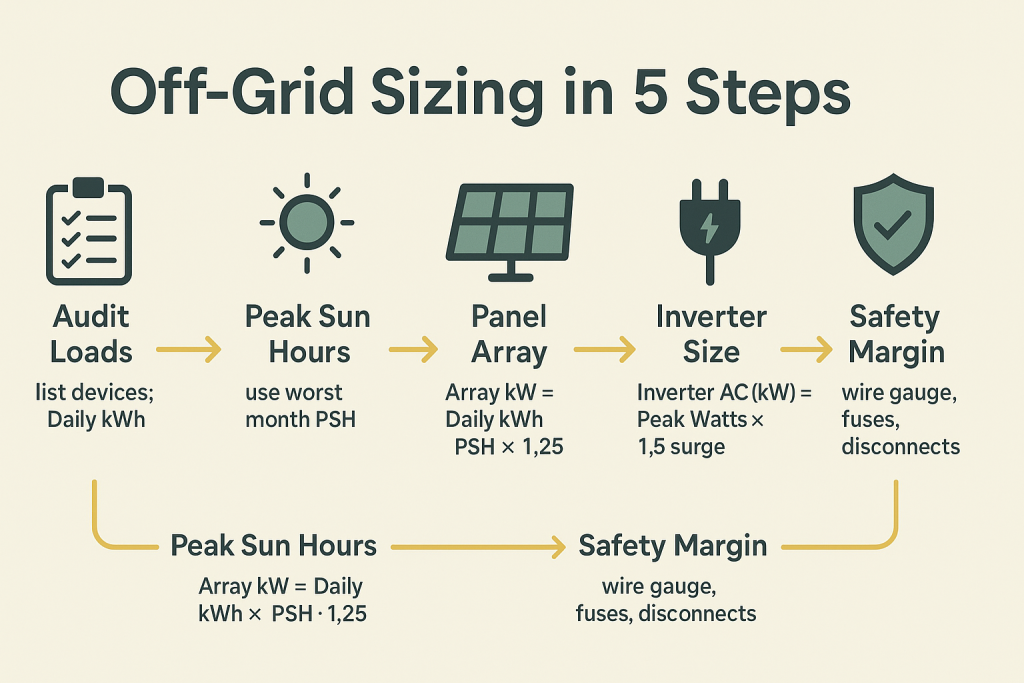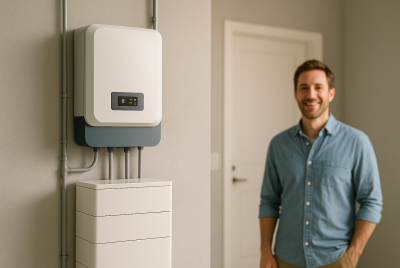Off Grid Solar System: Top Kits, Prices & Savings
You want real independence—lights on during outages, bills under control, and the quiet satisfaction of power that shows up with the sunrise. An off-grid solar system makes that possible. In this friendly guide, I’ll help you size a system, understand components, avoid expensive mistakes, and compare top kits (with pros/cons). If you decide to shop, you’ll also find a concise product roundup and comparison table.
What an off-grid solar system really means
No grid safety net. Your panels, batteries, charge controller, and inverter handle everything—day and night. That means careful sizing for your daily kWh, seasonal sunshine, and the appliances you actually use.
Off-grid vs. hybrid vs. grid-tied
- Off-grid: Full independence. Requires battery storage sized for nights + bad-weather days.
- Hybrid (grid + battery): Uses the grid as backup; great for outages but not full independence.
- Grid-tied (no battery): Cheapest per watt; no backup if the grid drops.
How to estimate your daily kWh (quick + accurate)
Do a 10-minute load audit: list devices, watts, and hours/day. Add 15–20% headroom for inverter losses and cloudy days.
12V vs 24V vs 48V (which voltage?)
- 12V for small RV/tiny setups (under ~1kW).
- 24V balances efficiency and cost for cabins.
- 48V reduces current for larger homes, improving efficiency and wire sizing.
Panels 101: wattage, efficiency, and what actually matters
Mono panels dominate now. Typical commercial module efficiencies cluster around ~20–25% for modern monocrystalline silicon, depending on the exact tech.

Batteries: lead-acid vs LiFePO4 (lithium iron phosphate)
- Lead-acid (AGM/gel): Lower upfront cost; heavier, lower usable capacity (50% DoD typical), shorter life.
- LiFePO4: Higher upfront, but lighter, deeper cycles, long life—often the better long-term value for daily cycling.
Controllers & inverters: MPPT, PWM, and pure sine
MPPT charge controllers extract more energy (and tend to be more cost-effective over time despite higher upfront cost). Pair with a pure sine wave inverter sized ~1.5× your largest expected load surge.
Mounting & wiring: small details, big wins
- Tilt and orient for your latitude.
- Use proper gauge cable to cut voltage drop.
- Add DC disconnects and fuses/breakers. Safety first.
Costs & payback: what to expect in 2025
Battery prices matter most for off-grid. A 2025 update from NREL estimates 4-hour Li-ion systems trending toward $147–$339/kWh by 2035 (2024$), depending on scenario; 2024 baseline around $334/kWh for utility-scale systems. Off-grid retail kits differ, but directionally, storage keeps getting more affordable over time.
Climate & roof angle: design for your sky
Northern latitudes benefit from a steeper winter tilt; desert climates need headroom for hot-weather output derating. Always factor your site’s peak sun hours and seasonal swings.
Common use cases (with real-life vibes)
- Cabins & tiny homes: 400–1200W arrays + 2–10 kWh batteries for essentials.
- RVs/vans: 200–600W arrays + compact LiFePO4 bank for quiet boondocking.
- Homesteads & farms: Larger arrays (1–5 kW+) with 10–30 kWh storage for tools, pumps, and cold storage. For a practical homestead upgrade, see this solar-powered irrigation system project guide for inspiration and planning. (Internal: smart irrigation with solar power)

Sizing snapshots (ballpark)
- “Essentials” setup (~4–6 kWh/day): 1.2–2.0 kW panels, 10–15 kWh LiFePO4, 3 kW inverter, 24–48V bus.
- “Cabin plus” (~8–10 kWh/day): 2–3 kW panels, 15–20 kWh LiFePO4, 5 kW inverter, 48V bus.
- “Family off-grid lite” (~12–15 kWh/day): 3–4 kW panels, 20–30 kWh LiFePO4, 6–8 kW inverter, 48V bus.
(Always adjust for climate, autonomy days, and actual appliances.)
Mistakes to avoid (learned the hard way)
- Under-sizing batteries: Nights and rainy weeks still happen.
- Ignoring wire size: Voltage drop steals watts silently.
- “Fridge? What fridge?” High-draw appliances require honest accounting.
- Mixing old/new batteries: Causes imbalance and premature wear.
Self-install or professional installation?
If you’re comfortable with wiring, torque specs, and NEC basics, small systems are doable. For 48V home systems or complex integrations, a licensed installer is worth it for safety and insurance.
Maintenance checklist (quick + simple)
- Quarterly: visual check for corrosion, loose lugs, conduit strain relief.
- Twice a year: clean panels, re-torque, inspect roof penetrations.
- Firmware/app: update inverter/monitoring as recommended.
🔹 Amazon Picks: 5 Off-Grid Solar Kits & Portable “Solar Generators”
(Each option includes a short take, core features, pros/cons, and who it’s for.)
1) Renogy 400W 12V Solar Starter Kit (MPPT)
What it is: A trusted starter kit for cabins/RVs with four 100W panels + MPPT controller; add your own battery/inverter to complete the system.
Features: 4×100W mono panels, Rover MPPT, cables/mounts.
Pros: Quality components; great for expanding; strong brand support.
Cons: Battery/inverter not included; 12V limits scale.
Best for: RVs, small cabins, weekend off-grid spots.
Review snapshot: Buyers like predictability and clear instructions; most complaints involve shipping/packaging.
2) ECO-WORTHY 1200W 24V Complete Kit (LiFePO4 + 3000W inverter)
What it is: A fuller “open-the-box” solution with panels, MPPT, LiFePO4 battery, and a 3kW inverter—nice value for cabins.
Features: 6×195–200W panels (varies by listing), 24V LiFePO4 bank, 60A MPPT, 3kW inverter, cables/racking.
Pros: True “complete kit” feel; 24V bus is efficient; LiFePO4 longevity.
Cons: Check listing closely for exact battery capacity/warranty; freight boxes are heavy.
Best for: Cabins/tiny homes needing plug-and-play simplicity.
Review snapshot: Praised as a budget-friendly, complete package; watch for inventory variations.
3) Jackery Solar Generator 2000 Plus (power station + solar panels)
What it is: A portable, expandable solar generator (Li-ion power station) that you can pair with foldable panels. Easy setup and great app.
Features: 2042Wh base (expandable), high surge output, fast charging, solar input with Jackery panels.
Pros: Very user-friendly; quiet; perfect for renters/nomads.
Cons: Cost per kWh is higher than “hardwired” kits; AC cycling loads need capacity planning.
Best for: Renters, RVs, backup power without wiring.
Review snapshot: Users love convenience; concerns center on cost and panel add-ons.
4) BLUETTI AC200L Solar Generator + PV panel kit
What it is: A powerful LiFePO4 power station (about 2 kWh) sold in bundles with 350W or 2×200W foldable panels; UPS-style transfer; RV-friendly ports.
Features: ~2400W AC output (power-lifting mode), 1200W solar input, fast AC charge, expansion battery options.
Pros: Robust outputs; expansion path; good port selection.
Cons: Heavy; premium pricing at higher capacities.
Best for: Mobile off-grid, light whole-home essentials during outages.
Review snapshot: Strong marks for build and speed; cost/weight are common trade-offs.
5) WindyNation 400W Off-Grid Kit (with inverter / AGM options)
What it is: Kit variations that bundle 3–4×100W panels, PWM controller, cables, and often AGM battery + 1500W inverter—a classic value route.
Features: Panel bundle, P30L controller, optional inverter/AGM batteries.
Pros: Good starter value; straightforward for RVs and small cabins.
Cons: PWM is less efficient than MPPT; AGM is heavier with lower usable DoD.
Best for: Budget builds and simple weekend cabins.
Review snapshot: Owners like the all-in parts list; watch specs (PWM vs MPPT) and plan future upgrades.
Comparison at a glance
| Model | Key Spec(s) | Warranty* | Approx Price/Tier | Best For |
| Renogy 400W 12V Starter Kit (MPPT) | 4×100W mono, MPPT controller | See listing | $$ | RVs, small cabins |
| ECO-WORTHY 1200W 24V Complete (LiFePO4 + 3kW) | ~1.2kW panels, LiFePO4 bank, 3kW inverter | See listing | $$–$$$ | Cabin/tiny home “plug-and-play” |
| Jackery Solar Generator 2000 Plus (+panels) | ~2kWh base, expandable, fast charge | See listing | $$$ | Renters, RVs, mobile |
| BLUETTI AC200L + panel kit | 2kWh LiFePO4, up to 1200W solar input | See listing | $$$ | Mobile off-grid, UPS backup |
| WindyNation 400W Off-Grid Kit (AGM/inverter) | 3–4×100W panels, PWM, AGM options | See listing | $–$$ | Budget starter builds |
*Manufacturer coverage varies; always confirm panel/electronics terms on the product page.

Research-backed insights you can trust
- Module efficiency today: The IEA PVPS Trends 2024 report notes commercial mono-Si modules commonly in the ~20–25% range—explaining why 400–500W class panels are mainstream now.
- Why MPPT usually wins: NREL’s comparative work shows MPPT-type (buck) controllers deliver improved efficiency and become more cost-effective over time than PWM, even with higher upfront cost—useful when you’re stretching every watt.
- Why off-grid matters globally: A 2024 World Bank/ESMAP summary projects off-grid solar as the most cost-effective path for 41% of people still without power by 2030—clear validation that decentralized solar + storage solves real problems.
- Battery cost direction: NREL’s 2025 update places 2024 4-hour Li-ion systems around $334/kWh, with mid- to long-term declines—helpful context when comparing LiFePO4 bank pricing in kits.
Bonus internal resource: Planning farm loads? Explore this step-by-step solar-powered irrigation system project guide for design ideas and parts planning. (Internal: off-grid irrigation planning guide)
Practical tips before you buy
- Start with loads, not panels. Your daily kWh decides everything.
- Choose LiFePO4 if you cycle daily. It protects long-term value.
- Prefer MPPT. Especially in cold/variable weather or partial shading.
- Design for winter. Size to your worst sun month, not your best.
- Think 48V for bigger homes. Lower current, safer wire sizes.
- Plan an expansion path. Buy gear that can grow (extra PV input, stackable batteries).
FAQs
How many panels are needed to power an off-grid cabin?
Divide your daily kWh by your worst-month peak sun hours, then add 20–30% headroom. Example: 6 kWh/day ÷ 3.5 PSH ≈ 1.7 kW; add headroom ≈ 2.0–2.2 kW.
What’s the ideal battery size for off-grid?
Multiply your daily kWh by 2–3 days of autonomy, then divide by 0.85 (losses). For 6 kWh/day: 6×2.5/0.85 ≈ 18 kWh usable (bigger climates may want more).
Is LiFePO4 worth it over AGM?
For daily cycling, yes—more usable capacity, faster charging, and longer cycle life typically offset the upfront premium over time.
Can I run AC and power tools off-grid?
Yes—size your inverter for running watts + surge and make sure your battery can deliver the amps. Many cabins use 5–6 kW pure sine inverters with 48V banks.
Should I DIY or hire a pro?
DIY is fine for small 12–24V systems. For 48V whole-home, multi-combiner arrays, or roof penetrations, hiring a licensed installer is the safer, often cheaper path long-term.
Wrap-up: Your path to quiet, resilient power
You don’t need perfection on day one. Start with a solid load audit, pick components that match your lifestyle (and climate), and choose a kit that can grow. Whether you want a simple cabin setup or a resilient homestead system, you’re closer than you think. You’ve got this—and every sunrise is on your side.




